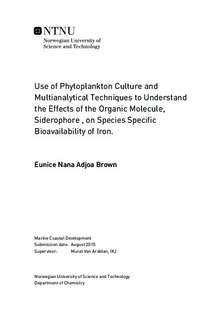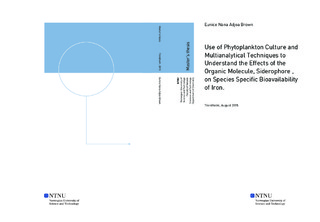| dc.description.abstract | Organic ligands play key roles in controlling the bioavailability of trace metals in the world oceans, thus influencing major biogeochemical cycles. The chemistry of organic ligands and the iron complexes formed, that in turn affect the species specific requirements of iron for different phytoplankton are still unknown. To study the effect of the interaction between iron and organic ligands over the growth of different phytoplankton species, a culture experiment was conducted with one species of diatom (Skeletonema costatum )and one of dinoflagellate (Alexandrium catenella), grown under two different iron concentrations and with a concentration gradient of siderophore (Des-ferroxamine B).Species were grown under EDTA-metal ion buffered seawater media Aquil (Price et al. 1988).Iron and siderophore were added every third day, to reach final concentrations for iron (1 and 10 nM) and siderophore (10,50, 100, 500, 2500 and 10000 nM).Before every addition, samples were collected for pH, quantum yield, in vivo fluorescence, cell abundance. Dissolved iron samples (Chelex-100 labile) were collected at the end for certain treatments. All measurements performed showed a marked effect of the high siderophore concentrations over the growth only of S.costatum, independent of the iron concentration for the first nine days. After this, the high siderophore treatments started to exhibit growth, reaching almost the levels exhibited in the control and lower siderophore treatments. A. catenella on the contrary showed slower growth pace, but with less or no evident effect of the siderophore concentration. Despite the initial inhibitory effect over the diatom growth, it can be observed that changes (e.g. release of organic ligands or changes in the siderophore chemistry) occurred in time, making S. costatum able to uptake the iron previously complexed. The responses exhibited show the different adaptive strategies, which under a climate change scenario may influence possible community structure shifts and changes in the biogeochemical cycles. | |

